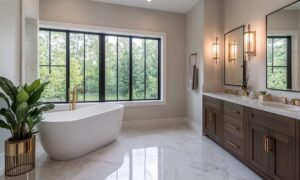London is a city of transformation. Its skyline shifts, its streets evolve, and its buildings tell stories of reinvention. This is clear in the trend of turning old commercial spaces, like factories, warehouses, and mills, into modern homes. These buildings, once alive with machinery sounds, now offer homes rich in character, charm, and history.
At the heart of this movement are the visionaries who bring these spaces back to life. Teddy, our lead architect, and Badrieh, our interior designer, are transforming London’s commercial history into a fresh residential future.
Why Commercial Conversions?
London commercial architecture has a unique charm that sets these properties apart. Their high ceilings, exposed brick, large windows, and steel beams create a raw vibe missing in many modern buildings. Builders made these spaces for function, not looks. But their practical design is what makes them stand out in a notable way.
For many Londoners, commercial-to-residential conversions represent the perfect blend of old and new. You get the solid craftsmanship of a historic building with the sleek comforts of contemporary design. And in a city where space is at a premium, repurposing existing structures makes both economic and environmental sense.
Breathing New Life into Old Spaces
Converting a commercial space into a home is no small task. It takes a keen eye to respect the building’s original character while adapting it for modern living. This is where Teddy shines.
As lead architect, Teddy has a deep appreciation for the stories these buildings hold. “The goal is to honour the past while making it livable for today’s needs,” he explains. “You don’t erase history—you build on it.”
This means our London architect keeps the original features when we can: the steel beams, the brickwork, and the big windows. It also means rethinking the space. You can add mezzanines, create new layouts, and make sure the structure meets modern insulation and energy standards.
But function alone isn’t enough. That’s where Badrieh comes in.
As an interior designer, Badrieh’s job is to soften these commercial spaces without stripping away their essence. “A warehouse doesn’t need to feel cold or harsh,” she says. “It’s about balance—mixing textures, introducing warmth, and making it feel like home.”
Her designs highlight contrast. They feature sleek modern kitchens with rugged brick walls. Plush furniture pairs well with iron-framed windows. Soft lighting balances the grandeur of these open-plan spaces.
The Future of London’s Commercial Conversions
London’s commercial past is vast, and so is its potential for reinvention. As more people want unique homes, warehouse-to-flat conversions are becoming a movement, not a trend.
With experts like Teddy and Badrieh at the forefront, these spaces are changing. They are not just old relics; they represent what can happen when history meets modernity. These conversions offer more than just homes—they create a bridge between the city’s past and its future. Every converted space tells a story, and every home is a testament to London’s ever-evolving character.
As the demand for unique living spaces grows, so does the creativity in their transformation. The fusion of heritage and innovation continues to redefine urban living.
Read More From Techbullion



































